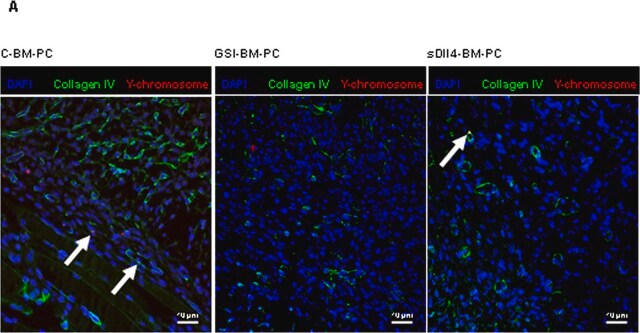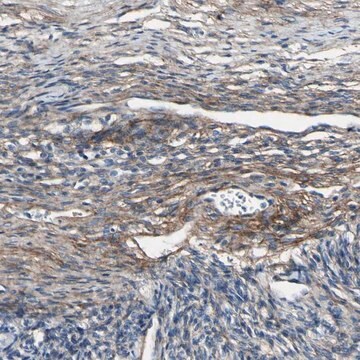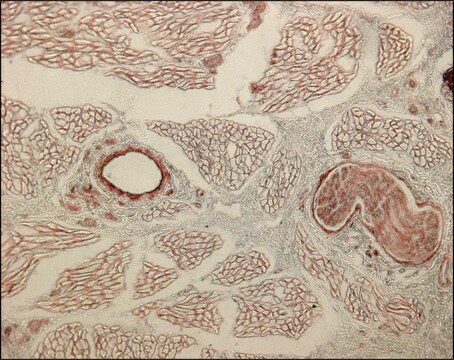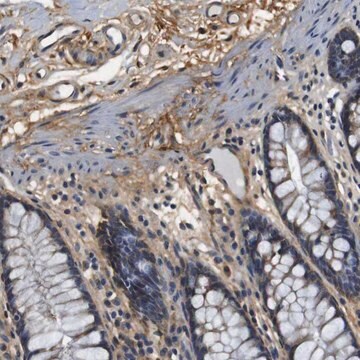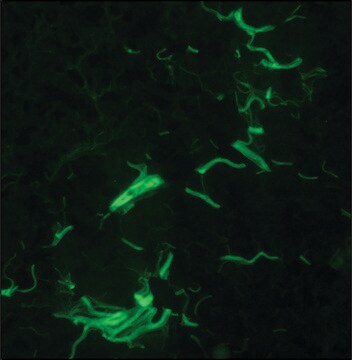MAB1944
Anti-Collagen Type VI Antibody, clone 3C4
ascites fluid, clone 3C4, Chemicon®
Synonim(y):
Collagen alpha-3(VI) chain, Collagen VI alpha-3 polypeptide
About This Item
Polecane produkty
pochodzenie biologiczne
mouse
Poziom jakości
forma przeciwciała
ascites fluid
rodzaj przeciwciała
primary antibodies
klon
3C4, monoclonal
reaktywność gatunkowa
human
producent / nazwa handlowa
Chemicon®
metody
electron microscopy: suitable
flow cytometry: suitable
immunocytochemistry: suitable
immunohistochemistry: suitable (paraffin)
immunoprecipitation (IP): suitable
izotyp
IgG1κ
numer dostępu NCBI
numer dostępu UniProt
Warunki transportu
dry ice
docelowa modyfikacja potranslacyjna
unmodified
informacje o genach
human ... COL6A3(1293)
Opis ogólny
Specyficzność
Immunogen
Zastosowanie
Immunocytochemistry Analysis: Representative lots detected extracellular type VI collagen immunoreactivity in cultured fibroblasts isolated from Ullrich congenital muscular dystrophy (UCMD) and Bethlem myopathy (BM) patients by fluorescent immunocytochemistry (Kim, J., et al. (2012). Neuromuscul. Disord. 22(2):139-148; Allamand, V., et al. (2011). Skelet Muscle. 1:30; Briñas, L., et al. (2010). Ann. Neurol. 68(4):511-520; Jimenez-Mallebrera, C., et al. (2006). Neuromuscul. Disord. 16(9-10):571-582; Tétreault, M., et al. (2004). Brain. 129(Pt 8):2077-2084; Zhang, R.Z., et al. (2002). J. Biol. Chem. 277(46):43557-43564).
Immunocytochemistry Analysis: A representative lot detected exogenously expressed wild-type α3(VI) chain, as well as α3(VI) chain with G49A or G301V mutation in SaOS-2 transfectants by fluorescent immunocytochemistry (Lamandé, S.R., et al. (2002). J. Biol. Chem. 277(3):1949-1956).
Immunocytochemistry Analysis: Representative lots immunostained extracellular type VI collagen fibrils in human MG63 osteosarcoma cells and primary foreskin fibroblasts cultures (Bruns, R.R., et al. (1986). J. Cell Biol. 103(2):393-404; Engvall, E., et al. (1986). J. Cell Biol. 102(3):703-710).
Immunohistochemistry Analysis: A representative lot detected human type VI collagen immunoreactivity in frozen muscle tissue sections from mice grafted with human synovial stem cells (hSSCs) by fluorescent immunohistochemistry (Meng, J., et al. (2010). Neuromuscul. Disord. 20(1):6-15).
Immunohistochemistry Analysis: Representative lots detected type VI collagen immunoreactivity in muscle and skin samples from congenital muscular dystrophy (CMD) and Ullrich congenital muscular dystrophy (UCMD) patients by fluorescent immunohistochemistry using frozen tissue sections (Peat, R.A., et al. (2008). Neurology. 71(5):312-321; Jimenez-Mallebrera, C., et al. (2006). Neuromuscul. Disord. 16(9-10):571-582).
Immunoprecipitation Analysis: A representative lot co-immunoprecipitated type VI collagen α1(VI) and α2(VI) chains with wild-type α3(VI) chain, as well as α3(VI) chain with G16S or G49A mutation. Impaired α1(VI) and α2(VI) co-IP was observed with α3(VI) G301V mutant (Lamandé, S.R., et al. (2002). J. Biol. Chem. 277(3):1949-1956).
Immunoprecipitation Analysis: A representative lot immunoprecipitated type VI collagen alpha chains from Triton X-100 extracts of MRC-5 human lung fibroblasts (Engvall, E., et al. (1986). J. Cell Biol. 102(3):703-710).
Electron Microscopy Analysis: A representative lot detected reduced extracellular type VI collagen immunoreactivity in cultured fibroblasts isolated from an Ullrich congenital muscular dystrophy (UCMD) patient (Zhang, R.Z., et al. (2002). J. Biol. Chem. 277(46):43557-43564).
Electron Microscopy Analysis: A representative lot immunostained extracellular filaments and fibrils by binding to the band (non-helical) region of the type VI collagen fibrils using cultured human foreskin fibroblasts (Bruns, R.R., et al. (1986). J. Cell Biol. 103(2):393-404).
Dot Blot Analysis: A representative lot detected exogenously expressed wild-type α3(VI) chain, as well as α3(VI) chain with G49A or G301V mutation in the medium of cultured SaOS-2 transfectants (Lamandé, S.R., et al. (2002). J. Biol. Chem. 277(3):1949-1956).
Cell Structure
ECM Proteins
Opis wartości docelowych
Postać fizyczna
Przechowywanie i stabilność
Informacje prawne
Oświadczenie o zrzeczeniu się odpowiedzialności
Nie możesz znaleźć właściwego produktu?
Wypróbuj nasz Narzędzie selektora produktów.
Kod klasy składowania
10 - Combustible liquids
Klasa zagrożenia wodnego (WGK)
WGK 1
Temperatura zapłonu (°F)
Not applicable
Temperatura zapłonu (°C)
Not applicable
Certyfikaty analizy (CoA)
Poszukaj Certyfikaty analizy (CoA), wpisując numer partii/serii produktów. Numery serii i partii można znaleźć na etykiecie produktu po słowach „seria” lub „partia”.
Masz już ten produkt?
Dokumenty związane z niedawno zakupionymi produktami zostały zamieszczone w Bibliotece dokumentów.
Nasz zespół naukowców ma doświadczenie we wszystkich obszarach badań, w tym w naukach przyrodniczych, materiałoznawstwie, syntezie chemicznej, chromatografii, analityce i wielu innych dziedzinach.
Skontaktuj się z zespołem ds. pomocy technicznej
